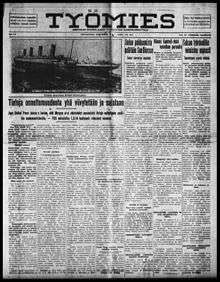Työmies

- Not to be confused with Työmies (1895), a publication of the Social Democratic Party of Finland published in Helsinki.
Työmies (The Worker) was a politically radical American newspaper written in the Finnish language. Launched as a weekly in July 1903, the paper later went to daily frequency and was issued under its own name until its merger with the communist newspaper Eteenpäin (Forward) in 1950 to form Työmies-Eteenpäin.
Työmies was affiliated with the Finnish Socialist Federation of the Socialist Party of America before later becoming a publication of the Communist Party, USA.
History
Establishment
Työmies was established in Worcester, Massachusetts in 1903 as Amerikan Suomalainen Työmies (The Finnish-American Worker).[1] In June 1904 the publication was moved to the small town of Hancock, located in the sparsely populated Upper Peninsula of Michigan.[1] The paper remained in that location for a decade before moving to the comparative metropolis of Superior, Wisconsin, a virtual twin city of Duluth, Minnesota.[1] Työmies' first Michigan-produced issue appeared on August 16, 1904, and included the election platform of Socialist Party Presidential candidate Eugene V. Debs.[2] Circulation of the paper grew to about 4,000 in that year.[2]
From its earliest days, Työmies was a Marxist publication, significantly more radical than its East Coast counterpart established in January 1905, Raivaaja (The Pioneer).[1] Both of these radical weeklies had broader organizational goals than merely bringing the news to a Finnish-American readership profitably, instead seeking to help construct a potent network of local Finnish-speaking groups to advance the cause of socialism through political and economic means.[3]
Local Finnish socialist groups began to centralize around the same period that Työmies (and Raivaaja) were launched, holding a convention at Duluth in 1904 as the "Finnish-American Labor League."[4] In 1906 the 73 affiliated Finnish locals were admitted to the Socialist Party of America (SPA) as the Finnish Socialist Federation, thereby adding between 2,000 and 3,000 members to the party's ranks.[5] The Finnish-Americans thereby became the first of the SPA's language federations, which would come to dominate the party's membership rolls by the end of the 1910s.
The Työmies Publishing Company briefly published an English-language paper called Wage Slave, and was the source of a number of annual magazines in the Finnish language.[1]
Työmies in the 1914 split
During the first years of the decade of the 1910s, the Finnish socialist movement had become deeply divided between a center-left majority faction (so-called "opportunists"), who sought to use electoral methods to attain state power and to initiate transformative reforms, and a left wing (so-called "impossibilists"), who considered all reformist gradualism to be useless and counterproductive and who instead favored the use of strikes and sabotage by the radical labor movement to bring about a revolutionary change.[6]
The "opportunists" continued to control the Finnish Socialist Federation through the organization's third triennial convention, held in June 1912 in Smithville, Minnesota, forcing the revolutionary industrial unionists to retreat from their support of the direct action methods espoused by the booming Industrial Workers of the World.[7] The radicals continued to agitate for their perspective, however, concentrating their efforts on the Federation-sponsored Work People's College, located at Smithville.[8]
In 1913 a massive strike of copper miners erupted in the Upper Peninsula of Minnesota, including a large number of Finns.[7] The strike was long and bitter, stretching into 1914, and ultimately government soldiers were called in to end the strike and restore the production of copper in the mines.[7] The defeat of the strike and widespread blacklisting of strikers further exacerbated the tactical differences among the Finnish-American socialists.[9]
Communist years
During its Communist Party phase, which began in about 1920, the circulation of the daily fluctuated in the range of 13,000 to 15,000 copies, declining to around 5,000 in 1950, at which time it was consolidated with the CPUSA's East Coast Finnish-language newspaper, Eteenpäin, to form Työmies-Eteenpäin.[1]
See also
Footnotes
- 1 2 3 4 5 6 Auvo Kostiainen, "Finns," in Dirk Hoerder with Christiane Harzig (eds.), The Immigrant Labor Press in North America, 1840s-1970s: An Annotated Bibliography: Volume 1: Migrants from Northern Europe. Westport, CT: Greenwood Press, 1987; pp. 234-235.
- 1 2 John I. Kolehmainen, Sow the Golden Seed, pp. 29-31.
- ↑ Peter Kivisto, Immigrant Socialists in the United States: The Case of Finns and the Left. Rutherford, NJ: Farleigh Dickinson University Press, 1984; pg. 96.
- ↑ Kivisto, Immigrant Socialists in the United States, pp. 96-97.
- ↑ Ira Kipnis, The American Socialist Movement, 1897-1912. New York: Columbia University Press, 1952. Cited in Kivisto, Immigrant Socialists in the United States, pg. 97.
- ↑ Auvo Kostiainen, The Forging of Finnish-American Communism, 1917-1924: A Study in Ethnic Radicalism. Turku, Finland: Turun Yliopisto, 1978; pg. 38.
- 1 2 3 Kostiainen, The Forging of Finnish-American Communism, pg. 39.
- ↑ Kostiainen, The Forging of Finnish-American Communism, pp. 39-40.
- ↑ Kostiainen, The Forging of Finnish-American Communism, pg. 40.
Further reading
- David Halkola, "Finnish Language Newspapers in the United States," in Ralph Jalkanen (ed.), The Finns in North America. Hancock, MI: Suomi College, 1969.
- P. George Hummasti, "The Working Man's Daily Bread: Finnish-American Working Class Newspapers, 1900-1921," in Michael Karni and Douglas Ollila (eds.), For the Common Good. Superior, WI: Työmies Society, 1977.
- John Kolehmainen, Sow the Golden Seed. Fitchburg, MA: Raivaaja Publishing Co., 1955.
- Auvo Kostiainen, Features of Finnish-American Publishing. Turku, Finland: Institute of History, 1977.
| ||||||||||||||||||||||||||
